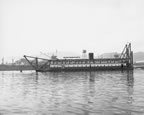 |
| The Oneonta was a side-wheel steamboat that operated on the Columbia River from 1863 to 1877 carrying freight and passengers on the stretch of the river between the Cascade Rapids eastward to The Dalles. |
A common assumption is that the many wharves and warehouses that lined Front Avenue in downtown Portland in the late 19th Century were for ocean going schooners and windjammers, and that tunnels ran under the streets to provide access to ocean-going ships for the Shanghaiing of sailors.
| The City of Salem taking on passengers at a dock somewhere near Salem sometime in the 1880s. |
Between 1836 when the first steamboat, the Beaver appeared on the Columbia to 1883 when railroads finally connected Portland to the rest of the world, hundreds of steam-powered paddle-wheelers were the main means of getting anywhere.
And there were hundreds of them, most built in Portland or elsewhere on the river, though some, like the Beaver, were built and launched as far away as London, England.
| The Portland waterfront in 1898. Notice it's all steamboats, no ocean-going craft along the wharves of downtown. |
Until the 1880's very few ocean-going ships could make it to Portland - the Columbia and Willamette Rivers were full of snags and sandbars making it simply too shallow and dangerous. So, freight was "lightered" from Portland on steamboats to Astoria where ships were loaded with their cargoes - and Shanghaied sailors. Despite what Captain John Couch said in 1845 about bringing ocean-going ships into Portland as far as today's Front and Washington, only the smallest of these ships could make it. During the fall months when the huge wheat harvest was being brought in, the low water in the rivers made a trip into Portland harbor impossible.
 |
| An early dredge adding depth to the channel somewhere on the Columbia or Willamette Rivers. |
This all changed starting in 1877 when U.S. Senator Henry Corbett got legislation through Congress paying for dredging of a channel on the system that large ocean going ships had a chance of making Portland. It didn't happen overnight, and even into the twentieth century the largest windjammers were loaded in Astoria.
This is the direct reason that Shanghaiing started in Astoria, not Portland, at least until the mid to late 1880s. Portland's "great" Shanghaiers of the age, from Bridget Grant and her sons to Jim Turk and the notorious, internationally known crimp Larry Sullivan all started in Astoria. Even the (in)famous Bunko Kelly and his brother William went from San Francisco to Astoria when they moved north. By the early 1890s these practitioners of the ancient art had moved to Portland. With branch offices in Astoria. All due to the shallow waters of the Columbia and Willamette Rivers.
Comments
Post a Comment